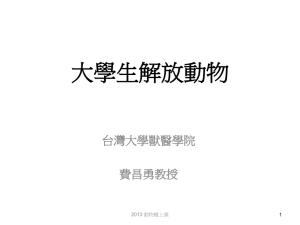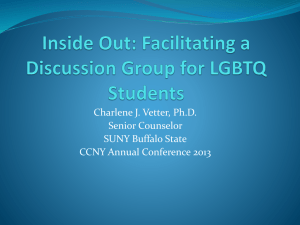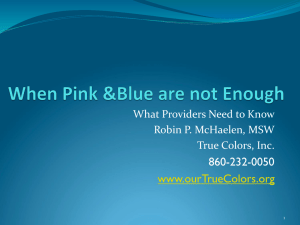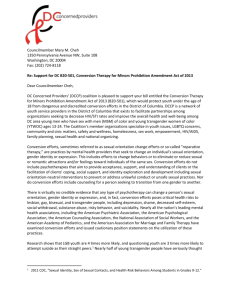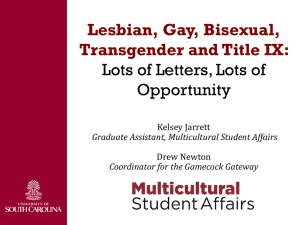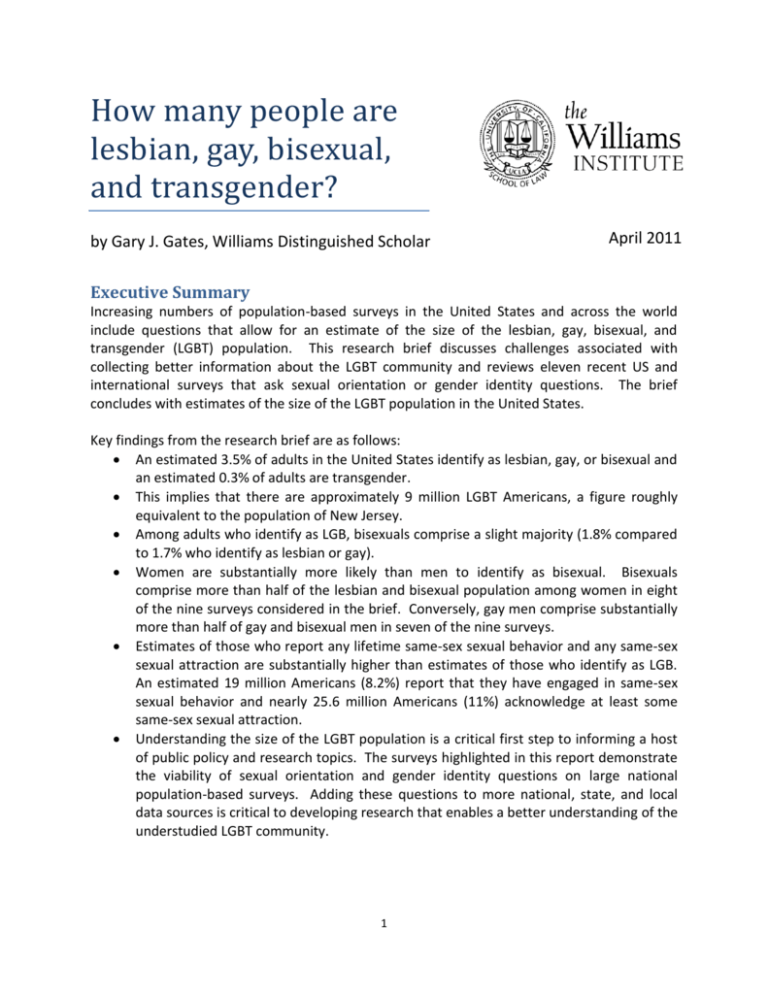
How many people are
lesbian, gay, bisexual,
and transgender?
by Gary J. Gates, Williams Distinguished Scholar
April 2011
Executive Summary
Increasing numbers of population-based surveys in the United States and across the world
include questions that allow for an estimate of the size of the lesbian, gay, bisexual, and
transgender (LGBT) population. This research brief discusses challenges associated with
collecting better information about the LGBT community and reviews eleven recent US and
international surveys that ask sexual orientation or gender identity questions. The brief
concludes with estimates of the size of the LGBT population in the United States.
Key findings from the research brief are as follows:
An estimated 3.5% of adults in the United States identify as lesbian, gay, or bisexual and
an estimated 0.3% of adults are transgender.
This implies that there are approximately 9 million LGBT Americans, a figure roughly
equivalent to the population of New Jersey.
Among adults who identify as LGB, bisexuals comprise a slight majority (1.8% compared
to 1.7% who identify as lesbian or gay).
Women are substantially more likely than men to identify as bisexual. Bisexuals
comprise more than half of the lesbian and bisexual population among women in eight
of the nine surveys considered in the brief. Conversely, gay men comprise substantially
more than half of gay and bisexual men in seven of the nine surveys.
Estimates of those who report any lifetime same-sex sexual behavior and any same-sex
sexual attraction are substantially higher than estimates of those who identify as LGB.
An estimated 19 million Americans (8.2%) report that they have engaged in same-sex
sexual behavior and nearly 25.6 million Americans (11%) acknowledge at least some
same-sex sexual attraction.
Understanding the size of the LGBT population is a critical first step to informing a host
of public policy and research topics. The surveys highlighted in this report demonstrate
the viability of sexual orientation and gender identity questions on large national
population-based surveys. Adding these questions to more national, state, and local
data sources is critical to developing research that enables a better understanding of the
understudied LGBT community.
1
Introduction
Increasing numbers of population-based surveys in the United States and across the world include
questions designed to measure sexual orientation and gender identity. Understanding the size of the
lesbian, gay, bisexual, and transgender (LGBT) population is a critical first step to informing a host of
public policy and research topics. Examples include assessing health and economic disparities in the
LGBT community, understanding the prevalence of anti-LGBT discrimination, and considering the
economic impact of marriage equality or the provision of domestic partnership benefits to same-sex
couples. This research brief discusses challenges associated with collecting better information about the
LGBT community and reviews findings from eleven recent US and international surveys that ask sexual
orientation or gender identity questions. The brief concludes with estimates of the size of the LGBT
population in the United States.
Challenges in measuring the
LGBT community
Similar to using sexual behaviors and attraction
to capture elements of sexual orientation,
questions may also be devised that consider
gender
expression and non-conformity
regardless of the terms individuals may use to
describe themselves. An example of these
types of questions would be consideration of
the relationship between the sex that
individuals are assigned at birth and the degree
to which that assignment conforms with how
they express their gender. Like the counterpart
of measuring sexual orientation through
identity, behavior, and attraction measures,
these varying approaches capture related
dimensions of who might be classified as
transgender but may not individually address all
aspects of assessing gender identity and
expression.
Estimates of the size of the LGBT community
vary for a variety of reasons. These include
differences in the definitions of who is included
in the LGBT population, differences in survey
methods, and a lack of consistent questions
asked in a particular survey over time.
In measuring sexual orientation, lesbian, gay,
and bisexual individuals may be identified
strictly based on their self-identity or it may be
possible to consider same-sex sexual behavior
or sexual attraction.
Some surveys (not
considered in this brief) also assess household
relationships and provide a mechanism of
identifying those who are in same-sex
relationships. Identity, behavior, attraction,
and relationships all capture related dimensions
of sexual orientation but none of these
measures completely addresses the concept.
Another factor that can create variation among
estimates of the LGBT community is survey
methodology. Survey methods can affect the
willingness of respondents to report
stigmatizing identities and behaviors. Feelings
of confidentiality and anonymity increase the
likelihood that respondents will be more
accurate in reporting sensitive information.
Survey methods that include face-to-face
interviews may underestimate the size of the
LGBT community while those that include
methods that allow respondents to complete
questions on a computer or via the internet
may increase the likelihood of LGBT
respondents identifying themselves. Varied
sample sizes of surveys can also increase
variation. Population-based surveys with a
Defining the transgender population can also be
challenging.
Definitions of who may be
considered part of the transgender community
include aspects of both gender identities and
varying forms of gender expression or nonconformity. Similar to sexual orientation, one
way to measure the transgender community is
to simply consider self-identity. Measures of
identity could include consideration of terms
like transgender, queer, or genderqueer. The
latter two identities are used by some to
capture aspects of both sexual orientation and
gender identity.
2
larger sample can produce more precise
estimates (see SMART, 2010 for more
information about survey methodology).
Kingdom, Australia, and Norway.
All are
population-based surveys of adults, though
some have age restrictions as noted.
A final challenge in making population-based
estimates of the LGBT community is the lack of
questions asked over time on a single large
survey. One way of assessing the reliability of
estimates is to repeat questions over time using
a consistent method and sampling strategy.
Adding questions to more large-scale surveys
that are repeated over time would substantially
improve our ability to make better estimates of
the size of the LGBT population.
The lowest overall percentage comes from the
Norwegian Living Conditions Survey at 1.2%,
with the National Survey of Sexual Health and
Behavior, conducted in the United States,
producing the highest estimate at 5.6%. In
general, the non-US surveys, which vary from
1.2% to 2.1%, estimate lower percentages of
LGB-identified individuals than the US surveys,
which range from 1.7% to 5.6%.
While the surveys show a fairly wide variation in
the overall percentage of adults who identify as
LGB, the proportion who identify as lesbian/gay
versus bisexual is somewhat more consistent
(see Figure 2). In six of the surveys, lesbian- and
gay-identified
individuals
outnumbered
bisexuals. In most cases, these surveys were
roughly 60% lesbian/gay versus 40% bisexual.
The UK Integrated Household Survey found the
proportion to be two-thirds lesbian/gay versus
one-third bisexual.
How many adults are lesbian,
gay, or bisexual?
Findings shown in Figure 1 consider estimates
of the percentage of adults who self-identify as
lesbian, gay, or bisexual across nine surveys
conducted within the past seven years. Five of
those surveys were fielded in the United States
and the others are from Canada, the United
3
The National Survey of Family Growth found
results that were essentially the opposite of the
UK survey with only 38% identifying as lesbian
or gay compared to 62% identifying as bisexual.
The National Survey of Sexual Health and
Behavior and the Australian Longitudinal Study
of Health and Relationships both found a
majority of respondents (55% and 59%,
respectively) identifying as bisexual.
The surveys show even greater consistency in
differences between men and women
4
associated with lesbian/gay
versus
bisexual
identity.
Women are substantially
more likely than men to
identify as bisexual. Bisexuals
comprise more than half of
the lesbian and bisexual
population among women in
eight of the nine surveys
considered (see Figure 3).
Conversely, gay men comprise
substantially more than half
of gay and bisexual men in
seven of the nine surveys.
estimates are true, it implies that approximately
0.1% of adults in California are transgender.
Four of the surveys analyzed also asked
questions about either sexual behavior or
attraction. Within these surveys, a larger
fraction of adults report same-sex attractions
and behaviors than self-identify as lesbian, gay,
or bisexual (see Figure 4). With the exception
of the Norwegian survey, these differences are
substantial. The two US surveys and the
Australian survey all suggest that adults are two
to three times more likely to say that they are
attracted to individuals of the same-sex or have
had same-sex sexual experiences than they are
to self-identify as LGB.
Several studies have reviewed multiple sources
to construct estimates of a variety of
dimensions of gender identity. Conway (2002)
suggests that between 0.5% and 2% of the
population have strong feelings of being
transgender and between 0.1% and 0.5%
actually take steps to transition from one
gender to another. Olyslager and Conway
(2007) refine Conway’s original estimates and
posit that at least 0.5% of the population has
taken some steps toward transition.
Researchers in the United Kingdom (Reed, et
al., 2009) suggest that perhaps 0.1% of adults
are transgender (defined again as those who
have transitioned in some capacity).
How many adults are
transgender?
Population-based data sources that estimate
the percentage of adults who are transgender
are very rare. The Massachusetts Behavioral
Risk Factor Surveillance Survey represents one
of the few population-based surveys that
include a question designed to identify the
transgender population. Analyses of the 2007
and 2009 surveys suggest that 0.5% of adults
aged 18-64 identified as transgender (Conron
2011).
Notably, the estimates of those who have
transitioned are consistent with the surveybased estimates from California and
Massachusetts.
Those surveys both used
questions that implied a transition or at least
discordance between sex at birth and current
gender presentation.
The 2003 California LGBT Tobacco Survey found
that 3.2% of LGBT individuals identified as
transgender. Recall that the 2009 California
Health Interview Survey estimates that 3.2% of
adults in the state are LGB. If both of these
5
How many lesbian, gay, bisexual
and transgender people are
there in the United States?
bisexual men. An estimate for the transgender
population is derived by averaging the findings
from the Massachusetts and California surveys
cited earlier.
Federal data sources designed to provide
population estimates in the United States (e.g.,
the Decennial Census or the American
Community Survey) do not include direct
questions regarding sexual orientation or
gender identity. The findings shown in Figure 1
suggest that no single survey offers a definitive
estimate for the size of the LGBT community in
the United States.
It should be noted that some transgender
individuals may identify as lesbian, gay, or
bisexual. So it is not possible to make a precise
combined LGBT estimate. Instead, Figure 5
presents separate estimates for the number of
LGB adults and the number of transgender
adults.
The analyses suggest that there are more than 8
million adults in the US who are LGB,
comprising 3.5% of the adult population. This is
split nearly evenly between lesbian/gay and
bisexual identified individuals, 1.7% and 1.8%,
respectively. There are also nearly 700,000
transgender individuals in the US. Given these
findings, it seems reasonable to assert that
approximately 9 million Americans identify as
LGBT.
However, combining information from the
population-based surveys considered in this
brief offers a mechanism to produce credible
estimates for the size of the LGBT community.
Specifically, estimates for sexual orientation
identity will be derived by averaging results
from the five US surveys identified in Figure 1.
Separate averages are calculated for lesbian
and bisexual women along with gay and
6
Averaging measures of same-sex sexual
behavior yields an estimate of nearly 19 million
Americans (8.2%) who have engaged in samesex sexual behavior.1 The National Survey of
Family Growth is the only source of US data on
attraction and suggests that 11% or nearly 25.6
million Americans acknowledge at least some
same-sex sexual attraction.2
By way of comparison, these analyses suggest
that the size of the LGBT community is roughly
equivalent to the population of New Jersey.
The number of adults who have had same-sex
sexual experiences is approximately equal to
the population of Florida while those who have
some same-sex attraction comprise more
individuals than the population of Texas.
The surveys highlighted in this report
demonstrate the viability of sexual orientation
and gender identity questions on large-scale
national population-based surveys. States and
municipal governments are often testing
grounds for the implementation of new LGBTrelated public policies or can be directly
affected by national-level policies. Adding
sexual orientation and gender identity
questions to national data sources that can
provide local-level estimates and to state and
municipal surveys is critical to assessing the
potential efficacy and impact of such policies.
1
This estimate uses data from the National Survey of
Family Growth and the General Social Survey.
2
Since the NSFG data only survey 18-44 year olds, this
estimate assumes that patterns in this group are the same
for those aged 45 and older. It may be that older adults
are less likely to report same-sex attraction. If so, this
estimate may somewhat overstate same-sex attraction
among all adults.
7
References
Australian Longitudinal Study of Health and Relationships. Australian Research Centre in Sex, Health and
Society, La Trobe University, Wave 1 Summary, 2005.
California Health Interview Survey, 2009. Author analyses of data using AskCHIS, UCLA Center for Health
Policy Research.
California LGBT Tobacco Survey, 2004. Author analyses using machine-readable data file. California
Department of Health Services, Tobacco Control Section.
Chandra, A, Mosher, WD, Copen, C. Sexual Behavior, Sexual Attraction, and Sexual Identity in the United
States: Data from the 2006-2008 National Survey of Family Growth. National Health Statistics
Report, Number 36, March 2011.
Note: This report includes estimates cited from the National Epidemiological Survey on Alcohol
Related Conditions and the National Survey of Sexual Health and Behavior.
Conron, KJ, Scott, G, Stowell, GS, Landers, S. Transgender Health in Massachusetts: Results from a
Household Probability Sample of Adults, American Journal of Public Health, forthcoming.
Conway, L. How Frequently Does Transsexualism Occur?, December 2002.
Joloza, T, Evans, J, O’Brien, R. Measuring Sexual Identity: An Evaluation Report, UK Office of National
Statistics, September 2010.
Olyslager, F, Conway, L. On the Calculation of the Prevalence of Transsexualism. Paper presented at the
WPATH 20th International Symposium, Chicago, Illinois, September 2007.
Reed, B, Rhodes, S, Schofield, P, Wylie, K. Gender Variance in the UK: Prevalence, Incidence, Growth,
and Geographic Distribution. Gender Identity Research and Education Society, June 2009.
SMART (Sexual Minority Assessment Research Team). Best Practices for Asking Sexual Orientation on
Surveys. Williams Institute, UCLA School of Law, November 2009.
Smith, TW, Marsden, P, Hout, M, Kim, J. Author analyses of 2008 General Social Survey using machinereadable data file. National Opinion Research Center, University of Chicago, 2009.
Tjepkema, M. Health care use among gay, lesbian and bisexual Canadians. Statistics Canada, Health
Reports, 19:1, March 2008.
About the Author
Gary J. Gates, PhD is the Williams Distinguished Scholar at the Williams Institute, UCLA School of Law. He
studies the demographic and economic characteristics of the LGBT population.
About the Institute
The Williams Institute on Sexual Orientation and Gender Identity Law and Public Policy at UCLA School
of Law advances law and public policy through rigorous, independent research and scholarship, and
disseminates its work through a variety of education programs and media to judges, legislators, lawyers,
other policymakers and the public. These studies can be accessed at the Williams Institute website.
For more information
The Williams Institute, UCLA School of Law
Box 951476
Los Angeles, CA 90095‐1476
(310)267‐4382
williamsinstitute@law.ucla.edu www.law.ucla.edu/williamsinstitute
8


